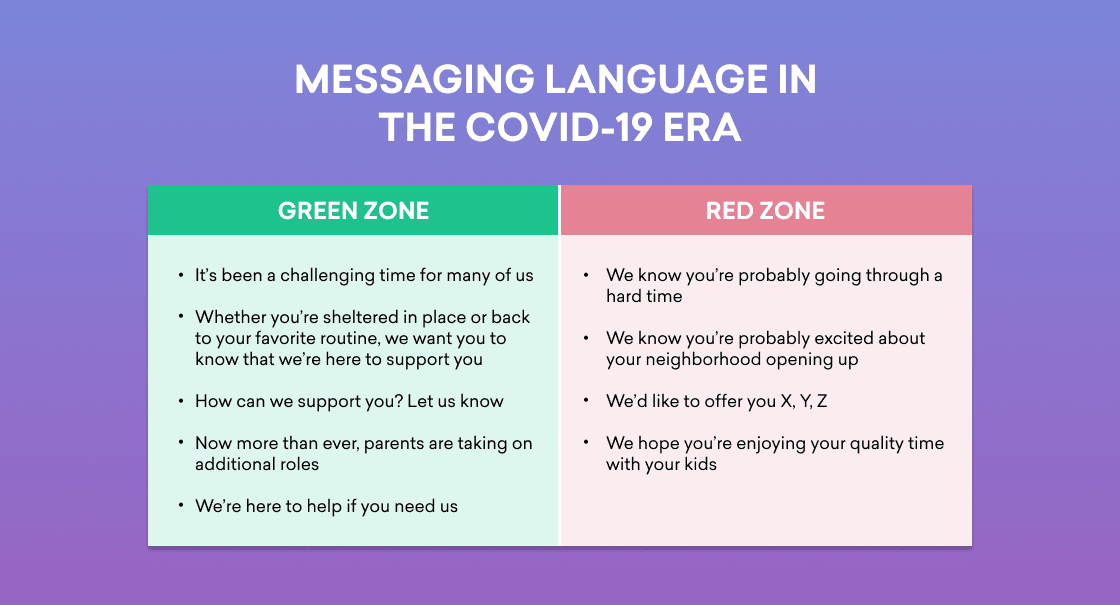Marketing to Humans in Times of Crisis: What Brands Need to Know
Published on September 01, 2020/Last edited on September 01, 2020/7 min read

Ritika Puri
Cofounder, StoryhackersThese days, every marketer is thinking through ways to become more empathetic. The COVID-19 crisis hasn’t exactly ended, and the news can be tough on everyone. Peoples’ emotions are on edge, which means that a communication misstep could wreak havoc on your brand. Not to mention, brands are under extraordinary pressure to step up and offer help. Earlier this year, Edelman launched its Trust Barometer, which found 78% of consumers say that they expect brands to protect employees and the local community.
Here’s the challenge you’re likely facing: As a marketing leader, you may not consider yourself a crisis communications expert. You’re in the business of selling products, building relationships, and getting the word out about your brand. But right now, being a leader in your field—and ensuring the economic wellbeing of your company and team—means addressing the crisis as part of your everyday communications. You have no choice but to step up, if you want your company to perform well in this challenging time.
To do that, you need an emotional intelligence toolkit to help effectively navigate this balancing act.
The Nature of the Crisis
What makes COVID-19 unique is that it isn’t an isolated incident. It is, at its core, an existential threat that forces every human being on this planet to ask hard questions about their way of life. Mary Meeker describes it as a “a hydra-like crisis”: That is, it’s a health crisis, intermixed with a political crisis, compounded by an economic crisis. Everyone, in every country, is experiencing the fallout.
TechStars Cofounder Brad Feld, known for writing about the connection between mental health and business outcomes, has argued that “we are actually dealing with the overlap of three linked crises.”
- Economic: Record unemployment, unpredictable financial markets
- Physical health: Lack of access to healthcare due to overrun systems
- Mental health: Spike in calls to crisis lines; likely lasting trauma
It’s important to keep this big picture front and center. Yes, your business needs to perform well in spite of the pandemic. But doing well, in the case of this once in a lifetime crisis, means getting through it. And getting through it means meeting your audiences where they are.
Your Crisis Communications Foundation
One of the challenges surrounding the COVID-19 pandemic is that everyone’s experience is unique. Some people live in resilient communities with low outbreak levels; others may be in regions where hospitals are overloaded. Some people may be parents who are getting used to homeschooling their children. Others may be navigating through financial difficulties—and illness or death in the family.
The best way to acknowledge others’ needs in your marketing communications is to understand that every situation is different. As a simple empathy-building exercise, you may want to create a simple set of personas. When you draft marketing campaigns, go through your list and ask yourself this core question: “How will this person respond to my message?”
Possible personas include:
- A parent who works in the tech industry, in a COVID-19 hot zone, who has 3 kids under the age of 10
- Someone who may be severely ill (or recovering) from COVID-19
- Someone who is caring for a sick friend or family member
- A college graduate who may have had their job offer rescinded
- A person who may be experiencing severe financial distress
- Someone who is living in a protest or conflict zone and may not be able to safely leave the house
As you create messaging and communication programs in this sort of environment, your goal should be twofold:
- Take steps to acknowledge the shared reality that your audience cohorts may be experiencing
- Try to avoid making assumptions about others’ experiences and their emotional reactions to those experiences

As an example, take a look at this recent campaign to help small business owners stay inspired and empowered. The message is clear, “we’re here for you, and this is what we’re doing if you need our help.” The end result? An empowering message during a difficult time.
Storytelling Themes for Empathy-Building
Empathy is about giving, in addition to receiving. During this time of crisis, your company needs to demonstrate a deep commitment to your audience's best interests. There are a few themes you can prioritize, to build a deeper sense of empathy in your brand communications.
There is no “going back” As the United Nations points out, there is only one path now: orward. The pandemic has challenged every “truth” about modern life. The question that everyone is now facing is how to live life safely. To speak effectively to consumers right now, your brand needs to acknowledge this reality.
What does that look like in practice? If you’re a brand with a big brick and mortar presence, it might mean building out a section on your app or website and sending emails and notifications to give customers clear, straightforward information about store reopenings, policies, and safety precautions. For digital-first brands, it might mean using in-app messages to help people in highly-impacted areas secure delivery slots and get the supplies they need. The key is to think about it from the customers’ point of view and keep what they need from your brand right now front of mind.
Life continuesWhile COVID-19 is on all of our minds, especially in the United States, we all need a break from talking about it. A recent study from the Pew Internet and American Life Project found that nine out of ten US residents follow COVID-19 news very closely—and that seven in ten need a break. Your marketing messages can be exactly that: A break from cognitive overload. Why not offer that break, even in your COVID-19 related communications?
Some brands have found success in this difficult time by building out programs focused on helping consumers and other businesses affected by COVID-19. This kind of approach foregrounds the real, human connection between the people who make up companies and people who are their customers and provides an opportunity to support, showcase, and celebrate those individuals, even in the midst of an incredibly trying time.
Simplicity wins
During the interconnected crises of 2020, many people are feeling spread thin. Between performing at work, processing stress, and coping with negativity in the media, it’s normal for human minds to feel exhausted. Researchers describe this psychological fatigue as “allostatic load.”
“Our stress hormones increase. We prepare to fight or flee,” explains Nancy Sin, assistant professor of psychology at the University of British Columbia. And as this pandemic continues and isolation drags on, “we’re having a lot of these physiological adaptations, each time we feel stressed, each time we feel worried. And over time, these repeated hits, physiologically and psychologically, can accumulate.”
When you’re developing marketing campaigns, give your audience’s brains a break. Keep your messages short. Use visuals whenever possible. Even a gesture as simple as closing on Thanksgiving—as several major brands have announced—can speak volumes about your brand’s character, trustworthiness, and investment in society.
Final Thoughts
It takes a village to survive a crisis. Every brand, reaching an audience, is in a position of power. You have the potential to reach and empower groups of people all over the world. Walk the talk in offering support. Show your audience that there exists a path forward—and that making money is only one part of your reason for being in business.
For more insight into how COVID-19 has affected the ways that consumers engage today, check out “COVID-19: The New Rules, By The Numbers.”
Related Tags
Be Absolutely Engaging.™
Sign up for regular updates from Braze.
Related Content
View the Blog
The future of payments: Enhancing innovation and trust in a changing landscape

Erin Bankaitis

Multichannel optimization: Unlocking a more cohesive strategy for engaging customers

Team Braze

Customer engagement must-haves for peak shopping season
